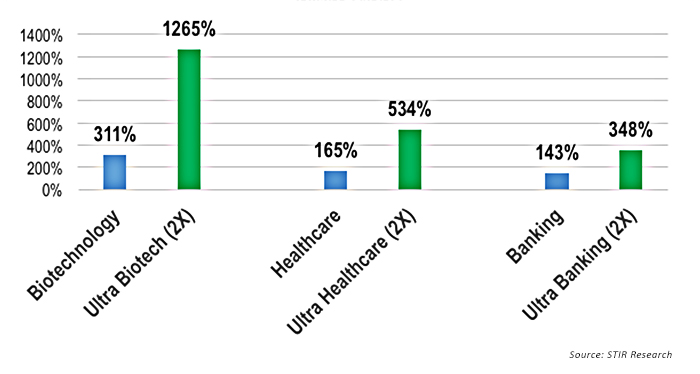
Ultra funds (leveraged funds) get an undeserved bad rap, causing many investors to miss the great investment opportunities they can provide. Investors are warned not to hold an ultra fund for longer than one day. In my opinion, this is really bad advice. It makes sense to buy an ultra fund when there is a strong cyclical bull market trend, where it can magnify gains well beyond the overall market or individual sectors.
But why the bad rep? It starts with blaming “tracking error” (the extent to which a fund’s net asset value—NAV—return differs from the underlying index’s return). The real difference lies in people’s failure to understand the math (the daily compounding).
An ultra (2X) fund seeks daily returns two times the daily performance of the underlying index. Here’s a quick example of the impact of daily compounding: Suppose the index rises 25% the first day and then falls 20% the second day. With the index initially priced at $100, it would rise to $125 on the first day and fall back to $100 on the second day. A 2X ultra fund (100% leveraged) would enjoy 2X the daily move: The first day it would rise 50% (2X the 25% index gain) to $150 and then fall 40% (2X times 20%), or $60 a share, to $90 the second day.
Many investors would yell and claim “tracking error.” The index was flat, but I lost 10%! How foolish. The ultra fund delivered exactly what it promised—2X the daily return. The daily compounding caused the difference. But here’s the great news: Daily compounding within an ultra fund in bull market runs doesn’t just double your return, it can extrapolate it.
Cyclical bull market (2011–2015)
Take a look at what really happened in the last bull market cycle and see the power of daily compounding at work.
POWER OF DAILY COMPOUNDING IN A BULL MARKET
(10/3/11–5/21/15)

- Biotechnology gained over 300%, and the ultra ETF (2X) didn’t do just twice as well (600%), it did four times better, a 1265% return.
- The ultra health care ETF didn’t just gain 330% (2X the index’s gain of 165%), instead it added another 200 full percentage points.
The larger the gain in the underlying index, the greater the magnification of the gain. It is misguided advice “to not hold an ultra fund for more than a day.” The monster, leveraged profits come in holding an ultra fund in a leading sector in a bull market for months and quarters.
Ultra funds can be a great addition to a portfolio, with three caveats: buy the leaders when the market is in a bull market run and manage risk.
1. Own the leaders in uptrends
The goal is to magnify the return, so why buy the whole market when you can buy the market leaders? Drill down and look for the leading sectors or industry groups. One of the best analytical tools is relative strength/momentum, following the maxim “What has been leading, will continue to lead!”
We have seen success evaluating the ranking (momentum studies) either monthly or quarterly, with look-back periods of 2, 3, 6, or 12 months. It is still important to diversify since relative strength, like any quantitative tool, will not always pick a perfect list of winners. How many ultra funds should you hold? Too many and you eventually own the whole market; too few and it becomes a matter of good luck or bad luck.
We have had great success starting with a universe of 13 “growth-oriented” sectors/industry groups and owning the four leading sectors. There is no magic to owning just four, more of a comfort level. Lastly, and this is extremely important, make sure that the chosen leader is in its own uptrend. While sectors tend to move in the direction of the overall market, go the extra step and identify the individual trend of the leading sector(s).
2. Use ultra funds only in bull markets
Stack the probabilities in your favor. Ultra funds carry more risk and volatility than the underlying index fund because of the leverage. After confirming the leading sector is in its own uptrend, go the next step and determine if the overall market is in a cyclical bull market. Currently the U.S. market is in a multiyear secular bull, and it just finished a cyclical bear market (5/21/15–2/11/16). A new bull market has just started. The average cyclical bull market gain in a secular bull market is over 90% and will go on for years. Therefore, the market today may just be in the early innings of a multiyear run.
3. Manage the risks
Touch and review the portfolio daily. Sector/industry groups will move quickly, and reverses in trends will occur faster than you can imagine. Drill down and analyze the trend of each sector daily. Review of the overall market trend can be conducted either daily or weekly. Have your risk-management strategy in place before you start, and do not stray from your discipline. Because of the power of leverage and daily compounding, ultra funds are not suitable for a buy-and-forget portfolio.
The biggest risk: Don’t exit too early. The temptation to lock in a 50% or 100% gain will be extremely high. Listen to the Wall Street wisdom: “Let your profits run and cut your losses short.”
And also remember the words of Albert Einstein: “Compound interest is the eighth wonder of the world.”
 Marshall Schield is the chief strategist for STIR Research LLC, a publisher of active allocation indexes and asset class/sector research for financial advisors and institutional investors. Mr. Schield has been an active strategist for four decades and his accomplishments have achieved national recognition from a variety of sources, including Barron's and Lipper Analytical Services. stirresearch.com
Marshall Schield is the chief strategist for STIR Research LLC, a publisher of active allocation indexes and asset class/sector research for financial advisors and institutional investors. Mr. Schield has been an active strategist for four decades and his accomplishments have achieved national recognition from a variety of sources, including Barron's and Lipper Analytical Services. stirresearch.com
